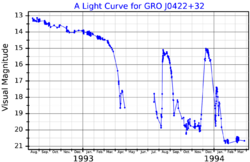Astronomy:GRO J0422+32
| Observation data Epoch J2000.0 Equinox (celestial coordinates) | |
|---|---|
| Constellation | Perseus |
| Right ascension | 04h 21m 42.77s[1] |
| Declination | +32° 54′ 26.7″[1] |
| Apparent magnitude (V) | 13.2 |
| Distance | 7,800[2] ly (2,400 pc) |
| Spectral type | M4.5V[1] + Black hole |
| Other designations | |
V518 Per, GRO J0422+33, RLC2006 XB2, Granat 0417+335, Nova Persei 1992, Nova Persei 1993, ZGH2005 OS00676-097731
GRO J0422+32, ZGH2005 XS00676B3-003 | |
| Database references | |
| SIMBAD | data |

GRO J0422+32[1] is an X-ray nova and black hole candidate that was discovered by the BATSE instrument on the Compton Gamma Ray Observatory satellite on 5 August 1992.[4][5] During outburst, it was observed to be stronger than the Crab Nebula gamma-ray source out to photon energies of about 500 keV.[2]
The mass of the black hole in GRO J0422+32 falls in the range 3.66 to 4.97 solar masses.[6] This is the smallest yet found for any stellar black hole, and near the theoretical upper mass limit (~2.7 M☉) for a neutron star. Further analysis in 2012 calculated a mass of 2.1 M☉, which raises questions as to what the object actually is.[7]
It is also known to have a companion M-type main-sequence star, V518 Per,[8] in the constellation Perseus. It has a magnitude of 13.5 in the B spectral band, and 13.2 in the visible band.
See also
References
- ↑ 1.0 1.1 1.2 1.3 "GRO J0422+32". SIMBAD. Centre de données astronomiques de Strasbourg. http://simbad.u-strasbg.fr/simbad/sim-basic?Ident=GRO+J0422%2B32.
- ↑ 2.0 2.1 Ling, J. C.; Wm; Wheaton, A. (2003). "BATSE Soft γ-Ray Observations of GROJ0422+32". Astrophys. J. 584 (1): 399–413. doi:10.1086/345602. Bibcode: 2003ApJ...584..399L.
- ↑ Chevalier, C.; Ilovaisky, S. A. (May 1995). "CCD photometry of GRO J0422+32 during activity and quiescence". Astronomy and Astrophysics 297: 103–114. Bibcode: 1995A&A...297..103C.
- ↑ Harmon, B. A.; Fishman, G. J.; Paciesas, W. S.; Briggs, M. S. (1993). "Gro J0422+32". International Astronomical Union Circular (5781): 2. Bibcode: 1993IAUC.5781....2H.
- ↑ McCrosky, R. E.; Mueller, J.; Schmeer, P. (1992). "Gro J0422+32 = GRS 0417+335". International Astronomical Union Circular (5597): 3. Bibcode: 1992IAUC.5597....3M.
- ↑ Gelino, Dawn M.; Harrison, Thomas E. (2003). "GRO J0422+32: The Lowest Mass Black Hole?". The Astrophysical Journal 599 (2): 1254–1259. doi:10.1086/379311. Bibcode: 2003ApJ...599.1254G.
- ↑ Kreidberg, Laura; Bailyn, Charles D.; Farr, Will M.; Kalogera, Vicky (2012). "Mass Measurements of Black Holes in X-ray Transients: is There a Mass Gap?". The Astrophysical Journal 757 (36): 17pp. doi:10.1088/0004-637x/757/1/36. Bibcode: 2012ApJ...757...36K.
- ↑ General Catalogue of Variable Stars, 3rd ed. (1971) Moscow[page needed]
 |
